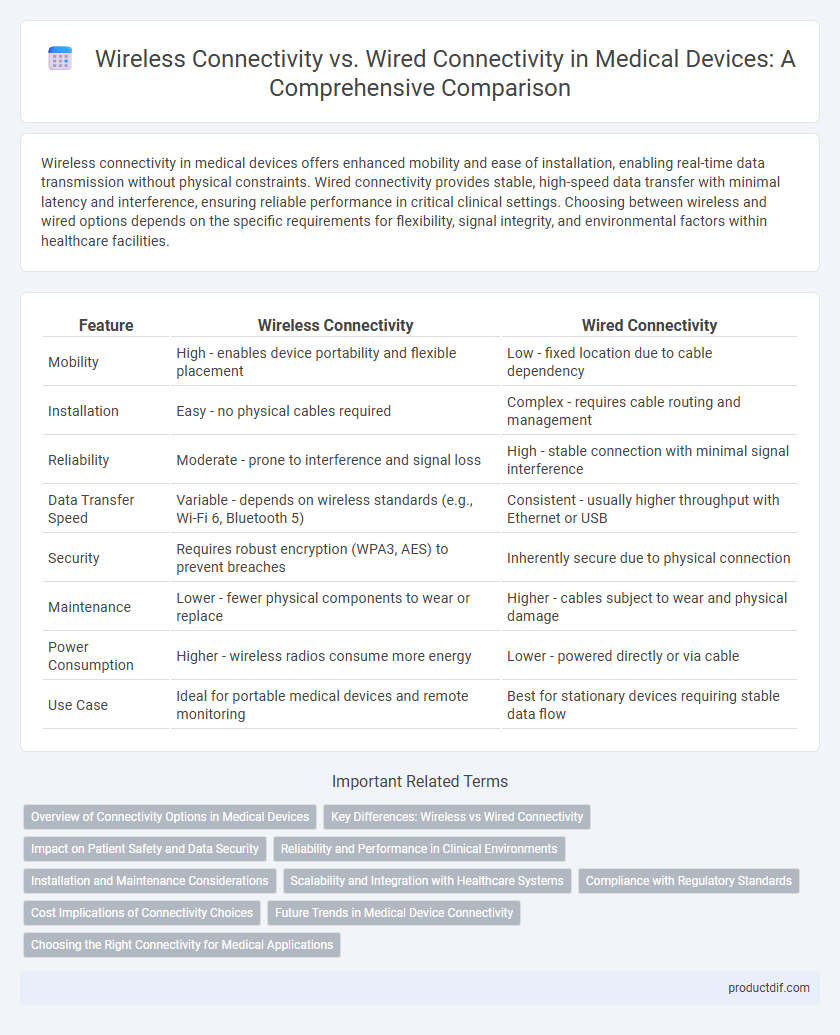Wireless connectivity in medical devices offers enhanced mobility and ease of installation, enabling real-time data transmission without physical constraints. Wired connectivity provides stable, high-speed data transfer with minimal latency and interference, ensuring reliable performance in critical clinical settings. Choosing between wireless and wired options depends on the specific requirements for flexibility, signal integrity, and environmental factors within healthcare facilities.
Table of Comparison
| Feature | Wireless Connectivity | Wired Connectivity |
|---|---|---|
| Mobility | High - enables device portability and flexible placement | Low - fixed location due to cable dependency |
| Installation | Easy - no physical cables required | Complex - requires cable routing and management |
| Reliability | Moderate - prone to interference and signal loss | High - stable connection with minimal signal interference |
| Data Transfer Speed | Variable - depends on wireless standards (e.g., Wi-Fi 6, Bluetooth 5) | Consistent - usually higher throughput with Ethernet or USB |
| Security | Requires robust encryption (WPA3, AES) to prevent breaches | Inherently secure due to physical connection |
| Maintenance | Lower - fewer physical components to wear or replace | Higher - cables subject to wear and physical damage |
| Power Consumption | Higher - wireless radios consume more energy | Lower - powered directly or via cable |
| Use Case | Ideal for portable medical devices and remote monitoring | Best for stationary devices requiring stable data flow |
Overview of Connectivity Options in Medical Devices
Wireless connectivity in medical devices offers enhanced mobility and remote monitoring capabilities, utilizing technologies such as Bluetooth, Wi-Fi, and cellular networks to facilitate real-time data transmission and patient monitoring. Wired connectivity, commonly employing USB, Ethernet, or serial connections, provides stable, high-speed data transfer with reduced interference, essential for critical applications requiring consistent power and security. Both connectivity types play crucial roles in optimizing device performance, data integrity, and user convenience within healthcare environments.
Key Differences: Wireless vs Wired Connectivity
Wireless connectivity in medical devices offers greater mobility and ease of integration with minimal physical infrastructure, enabling real-time data transmission across hospital networks. Wired connectivity provides more stable and secure data transfer with lower latency, essential for critical monitoring and high-bandwidth applications. Key differences include wireless's susceptibility to interference and potential security risks, whereas wired systems typically deliver consistent performance and enhanced data protection.
Impact on Patient Safety and Data Security
Wireless connectivity in medical devices enhances real-time patient monitoring and mobility but introduces risks related to signal interference, unauthorized access, and data breaches. Wired connectivity provides more stable data transmission and lower susceptibility to cyberattacks, thus ensuring higher reliability in sensitive patient care environments. Balancing wireless convenience with robust encryption protocols and secure network architecture is critical for maintaining patient safety and protecting confidential health information.
Reliability and Performance in Clinical Environments
Wireless connectivity in medical devices offers enhanced flexibility but may encounter interference and signal dropouts that impact reliability in critical clinical environments. Wired connectivity provides stable, high-speed data transmission with minimal latency, ensuring consistent performance essential for real-time monitoring and life-support systems. In settings where uninterrupted data flow is paramount, wired connections remain the preferred choice due to their superior reliability and predictable performance metrics.
Installation and Maintenance Considerations
Wireless connectivity in medical devices significantly reduces installation complexity by eliminating the need for extensive cabling, facilitating faster setup and easier repositioning in clinical environments. Maintenance is streamlined since wireless systems avoid cable damage issues and allow for remote diagnostics and software updates, minimizing downtime and reducing labor costs. However, wired connectivity provides consistent, interference-free connections, potentially lowering long-term maintenance related to signal integrity and security concerns in critical medical applications.
Scalability and Integration with Healthcare Systems
Wireless connectivity in medical devices offers superior scalability, enabling seamless expansion across healthcare facilities without the limitations of physical cabling. Integration with electronic health record (EHR) systems is more flexible via wireless protocols like Wi-Fi and Bluetooth, supporting real-time data transmission and remote monitoring. Wired connectivity provides stable, high-speed data transfer but lacks the adaptability necessary for dynamic healthcare environments and scalable network architectures.
Compliance with Regulatory Standards
Wireless connectivity in medical devices requires rigorous adherence to FCC, IEEE 802.11 standards, and HIPAA for data security, ensuring seamless integration and patient safety. Wired connectivity offers straightforward compliance with established IEC 60601-1 standards for electrical safety and EMC, reducing risks of interference and data breaches. Both connection types must continuously meet evolving FDA and ISO 13485 regulations to maintain certification and market approval.
Cost Implications of Connectivity Choices
Wireless connectivity in medical devices often reduces installation and maintenance costs by eliminating the need for extensive cabling and physical infrastructure, leading to lower upfront expenses. Wired connectivity, while typically incurring higher installation costs due to labor and materials, can offer more stable and secure data transmission, potentially minimizing long-term costs associated with data loss or interference. Evaluating cost implications requires balancing the initial investment against operational efficiency, device reliability, and environmental factors specific to healthcare settings.
Future Trends in Medical Device Connectivity
Future trends in medical device connectivity emphasize seamless integration of wireless technologies such as 5G and Wi-Fi 6, enabling real-time data exchange and remote patient monitoring with minimal latency. Enhanced cybersecurity protocols and IoT interoperability standards are pivotal to ensuring secure and reliable wireless communications within healthcare ecosystems. Despite the rise of wireless solutions, wired connections remain crucial in high-reliability scenarios requiring stable power supply and uninterrupted data transmission, particularly in critical care environments.
Choosing the Right Connectivity for Medical Applications
Wireless connectivity in medical devices offers enhanced mobility and real-time data transmission crucial for patient monitoring and remote diagnostics. Wired connectivity provides superior reliability and security, making it ideal for critical applications requiring uninterrupted, stable data flow such as surgical equipment and life-support systems. Selecting the right connectivity depends on balancing factors like latency tolerance, environmental interference, power consumption, and data sensitivity specific to the medical use case.
Wireless connectivity vs Wired connectivity Infographic

 productdif.com
productdif.com